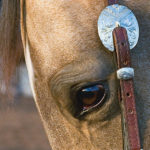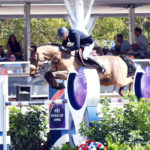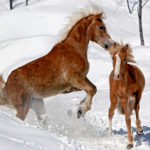At some point in your horse life, chances are you’ve found yourself wondering whether training setbacks or new behaviors might have some underlying medical cause. After all, your horse can’t talk. He depends on you to listen to his behavior instead.

In this article, I’m going to introduce you to some horses whose odd behaviors really were the result of underlying medical disorders. I’ll tell you what behaviors they exhibited that got the attention of their owners, and what was really wrong. You’ll soon understand why it’s so important to listen to your horse when he tells you something isn’t right—and why you must take steps to find out why he’s acting strangely.
Persistent Head-Flipping
Frank is an 11-year-old pony who started violently flipping his head. He’d toss it up and down, sometimes with a full swing but often just a little flick. He’d snort, sneeze, and occasionally stop and rub his nose on his leg. The behavior was most severe when Frank was being ridden, although he occasionally flipped his head even when resting in his stall—especially on very hot days. His trainer changed the bit several times and tried to control the behavior with a martingale, but it just got worse and worse.
The diagnosis: When a dental exam, skull radiographs, and endoscopic examination of Frank’s nasal passages came up empty, the pony’s head-tossing behavior was determined to be caused by trigeminal neuralgia—a painful disease that causes persistent tingling and pain in the nerve that provides sensation to the face and muzzle. The condition can occur in response to a variety of stimuli, including heat, light, stress, and allergies. Recent work has demonstrated that it even can be related to activity of some reproductive hormones, which may explain why it often occurs seasonally, starting in the spring.
This head-shaking syndrome is most common in geldings between 9 and 11 years of age, and Frank’s up-and-down head-flinging pattern, small head flips, and occasional rubbing are very typical.
The outcome: Frank was first outfitted with a nose net, that he wore whenever he was working. These nets can make a difference in 40 percent of cases, but it didn’t seem to help Frank much. He then was treated with a medication called cyproheptadine, that also can be beneficial for approximately 40 percent of horses with this problem. Frank did respond well to this medication, and most of his head-flipping behavior has disappeared.

Fortunately, Frank is a lesson pony who doesn’t attend any recognized shows where this medication wouldn’t be allowed. His symptoms disappear during winter months, and his owner is able to manage his disease and eliminate the behavior by treating him with cyproheptadine every spring and summer.
Balky Under Saddle
Sam is a 9-year-old Paint gelding who’s always been a pretty reliable mount. He’s quiet, safe, and an experienced breed-show pleasure horse. His young rider started having troubles at mid-show season. Sam seemed fine around the barn and looked great on the longe line, but when asked to work under saddle, he’d simply plant his feet, pin his ears, and refuse to move. Time off didn’t help. When the trainer hopped on board to try to fix the problem, Sam convincingly said “no.” When the trainer became more insistent, Sam bucked so violently that he unloaded the trainer and sent him to the hospital
The diagnosis: The vet didn’t see any lameness during a full examination, and lab work was normal. Nuclear scintigraphy or “bone scan” was recommended, a procedure in which Sam was injected with a radioactive substance to identify areas of increased blood flow.
The bone scan showed a very focal area of inflammation in the middle of Sam’s back, and subsequent radiographs showed that the tall spines on top of his vertebrae were rubbing together. Sam was suffering from impinging dorsal spinous processes, or “kissing spines,” an extremely painful back condition that often only causes problems when a horse is working under saddle.
The outcome: Sam’s back was treated with an injection of corticosteroids and administration of Tildren, a medication that helps control bone inflammation. He showed remarkable improvement for the first two to three months after treatment. His resistant behavior disappeared, and he finished out a successful competition season—confirming that the problem with his back truly was the underlying cause of his bad behavior.
Unfortunately, four months after he was initially treated, the behaviors returned. His owners face choosing whether to have surgury performed on his back to help alleviate his ongoing discomfort, or if it’s simply time for Sam to retire.
Aggressive Mare
Annie is a 14-year-old Quarter horse mare who started acting aggressively toward her pasturemates. She’d raise her head, prance, and whicker like a stallion—especially when she saw another mare in heat. Her owner assumed she was simply a dominant mare, until Annie’s behavior escalated to the point where she was difficult to handle. Eventually, she became downright dangerous, and her owner called the vet.
The diagnosis: The vet performed an ultrasound examination of Annie’s uterus and ovaries, and discovered that one ovary was quite enlarged, while the other appeared abnormally small. His suspicion that Annie might have a granulosa-thecal cell tumor was confirmed with blood work, where hormone elevation consistent with this type of tumor was identified. These tumors are fairly common in mares. They release testosterone, the hormone that results in typical stallion-like behavior.
The outcome: Annie’s diseased ovary was surgically removed. Fortunately, it was still small enough that surgery could be performed through a flank incision in the mare’s side, rather than requiring full anesthesia to approach the ovary from her midline. Annie was fully recovered from surgery after three months, and ready to go back to work. Her unusually aggressive behavior disappeared. Two years after surgery, her owner decided to try having Annie bred. Her remaining ovary had become fully functional once the hormonal influences of the tumor were eliminated, and she successfully produced a foal the following spring.

Head-Pressing and More
Charlie was a 19-year-old Arabian gelding who’d always been super sweet and easy to manage, until he started getting cranky and “whacked out.” He’d pin his ears, bite at his owner during grooming time, and just generally be out of sorts. He also started yawning while standing on the cross-ties. Charlie’s owner didn’t think much of her horse’s gradual behavior change at first, figuring he was just getting older. But one day, she came to the barn and found Charlie standing in the corner with his head pressed against the wall. “What on earth?” she wondered. “Maybe something’s really wrong.” Time to call the vet.
The diagnosis: Charlie’s vet was quite concerned about the gelding’s behavior. Not only did he seem depressed, he also circled relentlessly in his stall until he decided to take a break—with his head pressed against the wall. And the vet was right to be concerned!
Blood work confirmed that Charlie was experiencing problems with his liver. An ultrasound and biopsy were performed, and results of these tests showed that Charlie was indeed in advanced liver failure. The odd behaviors he was exhibiting were consistent with hepatic encephalopathy—the result of toxins that accumulate and affect the brain when the liver is failing and can’t do its job.
The outcome: With liver failure, signs often aren’t recognized until as much as 80 percent of the liver is compromised. Sadly, Charlie’s disease was quite advanced by the time he was diagnosed, and he was humanely euthanized.
Kicking When Eating
Ken is a 10-year-old Thoroughbred gelding who’s always been a sensitive type. He was super-aggressive during feeding time, pinning his ears and kicking violently at the wall whenever he was fed. His owner tried all of the recommendations for modifying his aggressive feeding-time behavior, including witholding food until he put his ears forward and standing on top of his hay pile to establish dominance. She even tried kicking chains with no success. Then one day, Ken had a serious colic episode, and his owner had to bring in the vet.
The diagnosis: Ken’s vet determined that the gelding’s colic symptoms were severe, and abnormal results of a rectal examination indicated surgery. Once the operation began, the vet discovered that Ken had a previous colic surgery that caused adhesions between several sections of his intestines and were likely causing things to move abnormally, allowing gas to accumulate during digestion.
The outcome: The vet corrected the existing adhesions, and Ken recovered uneventfully from his second colic surgery. Most amazing was that all of his abnormal feeding-time behaviors disappeared after he recovered.





